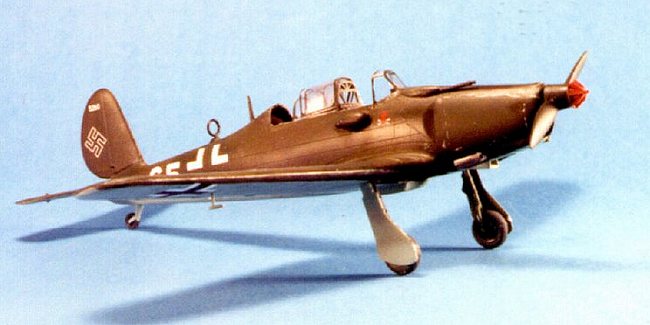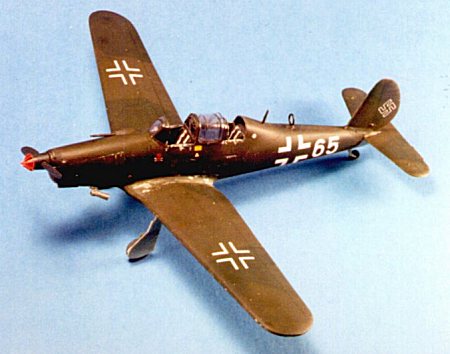
Special Hobby 1/48 Arado Ar-96B-2
|
KIT # |
48006 |
|
PRICE: |
$17.98 |
|
DECALS: |
One each: Luftwaffe, Czech,Hungarian |
|
REVIEW: |
|
|
NOTES: |
|
TOOTH-CUTTER FOR THE JAGDWAFFE

|
HISTORY |
One of a handful of small companies with aircraft design and manufacturing experience that would become the nucleus of the German aircraft industry after Hitler came to power, Arado Flugzeugwerke G.m.b.H. became one of the most important aircraft manufacturing companies of the Third Reich despite the fact that only a very few of the airplanes that came off the production line were from designs initiated by the company. It began life as the Warnemuende company during the First World War, changing its name to Arado-Handelsgesellschaft in 1925. During the 1920s and early 1930s, the design office was prolific, creating the S.I primary trainer in 1925 and following it a year later with the SC.I and SC.II advanced trainers. German policy during this period was to secretly keep pace with current military aviation technology abroad, and this produced the SD.I single seat fighter in 1928, to be followed by the SD.II and SD.III fighter biplanes and the SSD.I float fighter by 1929. When the Nazis came to power, the company had just produced the Ar-64 single-seat fighter, which would be immediately followed by the Ar-65, the first fighter equipment of the still-secret Luftwaffe. With a major infusion of funds from the German government, the company came under the control of the RLM in 1934, and the design office became deeply involved with development and production of the Ar-68 series. Despite the fact this airplane looked ungainly in comparison with the elegant Heinkel He-51 biplane, the Ar-68 was decidedly superior, the equal of any fighter biplane currently in service in 1935.
 Unfortunately, Arado stuck to traditional designs at a time when a revolution
was happening in aircraft development. The company's contender for the new
Luftwaffe monoplane fighter was completely outclassed by its competitors from
Focke-Wulf, Heinkel and Messerschmitt. By 1938, Arado's main product was the
Messerschmitt Bf-109, the winner of that competition. The Ar-69 primary trainer
came off second to the Fw-44 Steiglitz, the Ar-76 light fighter/trainer
was beaten by the Fw-56 Stosser, and the Ar-77 twin engine
trainer/utility aircraft lost to the Fw-58 Weihe.
Unfortunately, Arado stuck to traditional designs at a time when a revolution
was happening in aircraft development. The company's contender for the new
Luftwaffe monoplane fighter was completely outclassed by its competitors from
Focke-Wulf, Heinkel and Messerschmitt. By 1938, Arado's main product was the
Messerschmitt Bf-109, the winner of that competition. The Ar-69 primary trainer
came off second to the Fw-44 Steiglitz, the Ar-76 light fighter/trainer
was beaten by the Fw-56 Stosser, and the Ar-77 twin engine
trainer/utility aircraft lost to the Fw-58 Weihe.
The fortunes of the company took an upturn in late 1938 with the Luftwaffe's decision to adopt the Ar-96A as the service's advanced flight trainer. The airplane had been designed in 1936-37, and was an elegant two-seater with an enclosed cockpit that had good visibility for both pilots, powered by an Argus As 410A-1 12 cylinder inverted-vee air-cooled engine of 465 h.p. The airplane was tractable and supremely maneuverable. Unfortunately for Arado, the company was so deeply committed to license production of other companies' designs that AGO had to take over production of the Ar-96 until mid-1941, when production was shifted Avia in Czechoslovakia. The main production type was the Ar-96B-2, which was armed with a single 7.72mm machine gun so that it could double as a gunnery trainer. Avia was joined by Letov in 1944.
The airplane was used as a trainer by the Hungarian Air Force as well as the Luftwaffe. Post-war, it continued in production in Czechoslovakia until the mid 1950s, being used as the standard trainer for the Czech Air Force until the late 1950s.
|
THE KIT |
 Until this release from Special Hobby, the only way a 1/48 modeler could add
an Ar-96 to their collection was by making a model from the Karo-As vacuform,
which appeared in the 1980s from West Germany. While this company has an
excellent reputation with its products, the fact it was a trainer and a vacuform
worked against any wide sales here in the U.S. There was also a 1/72 Ar-96 made
by Heller in the 1970s which is still available and can be highly recommended
for quality.
Until this release from Special Hobby, the only way a 1/48 modeler could add
an Ar-96 to their collection was by making a model from the Karo-As vacuform,
which appeared in the 1980s from West Germany. While this company has an
excellent reputation with its products, the fact it was a trainer and a vacuform
worked against any wide sales here in the U.S. There was also a 1/72 Ar-96 made
by Heller in the 1970s which is still available and can be highly recommended
for quality.
The Special Hobby kit comes on two light grey sprues, with a bag of resin for the cockpit and wheel well, and one well-done vacuform canopy. While there is a certain amount of flash to be cleaned off, and it is still a good idea to cut the parts from the not-so-thick-as-usual sprues with a razor saw, this kit overall is a technical improvement for its manufacturer, MPM.
|
CONSTRUCTION |
I first cut off the main parts and cleaned them up. This included cutting off a number of ejector pins from the inner surfaces of both the wings and fuselage. There were no sink marks on the outer surfaces.
I then removed the resin cockpit parts from their backing, and painted everything with Gunze-Sanyo RLM66 Schwartzgrau.
While that was drying, I started cutting the wheel well off the backing block. Eventually, I had to cut the wheel well in half to get the block removed, and then there was a prolonged bit of sanding the wheel wells and test-fitting to get them into the wings. If I was going to do this again, I would abandon the resin wheel well, and merely box off the holes in the wing with thin sheet styrene; the end result would look as good without nearly the hassle. It must be mentioned that this was the only "hard part" of this model. I sanded the wings to get thin trailing edges, and glued them together.
While all that was setting up, I proceeded to finish detail painting the cockpit and assemble it. The resin castings for the cockpit are uniformly excellent; I particularly liked the molding of the seats, with crisp-looking seat belts that were turned and twisted like the real item. Once the cockpit detailing was finished I assembled the cockpit into the fuselage and assembled the fuselage. I glued on the horizontal stabilizer and aligned it, then set things aside to set up.
With the two major sub-assemblies of fuselage and wings ready, I glued them together. Fit was excellent for a limited-run kit. I filed and sanded all seams, and only needed putty on the wing-to-fuselage joints, the others being easily filled with Gunze Mr. Surfacer 500.
|
PAINT & DECALS |
 I shot the model overall light grey to check seams, then shadow-shaded panel
lines and fabric depressions with flat black. The model was painted in the
standard Luftwaffe scheme of RLM70 Schwartzgrun and RLM71 Dunkelgrun
upper surfaces and RLM65 Hellblau lower surfaces, following the painting
pattern in the kit instructions.
I shot the model overall light grey to check seams, then shadow-shaded panel
lines and fabric depressions with flat black. The model was painted in the
standard Luftwaffe scheme of RLM70 Schwartzgrun and RLM71 Dunkelgrun
upper surfaces and RLM65 Hellblau lower surfaces, following the painting
pattern in the kit instructions.
The decals are from Propagteam, and went down easily with a bit of Micro-Sol. I used the markings for a Luftwaffe trainer circa late 1944.
I shot the model with two coats "Flat Future" to get the semi-matte finish of Luftwaffe aircraft, then did a few "dings" with Model Master Aluminum non-buffing applied with a brush. I used Tamiya "Smoke" thinned 50-50 with alcohol for the exhaust stains.
The canopy had been Futured and painted before attachment. When I cut it off its base and test-fitted it, it was just a tad short, which could have been fixed at an earlier construction stage with Zap-A-Gap and putty - not a viable solution here. I decided that since the cockpits were so nice-looking, I would open the canopies (even though the cockpits could have been easily seen through the very-clear canopy). This solved the fit problem and gave a realistic look to the final result.
|
CONCLUSIONS |
I built this model over the course of four days. For a limited-run kit - particularly one from MPM - that is the equivalent of a "slammer." As you will read from Scott in his upcoming review of the Special Hobby XF-85, this is not always the case with Special Hobby kits.
The Ar-96 is a good-looking airplane. I wish more of them had survived to end up in the restored warbird scene. It's an important airplane in the history of the Luftwaffe, and a must-have for anyone attempting to create a complete collection of significant Luftwaffe aircraft of the Second World War.
Thanks to Squadron Mail Order for providing the review kit.